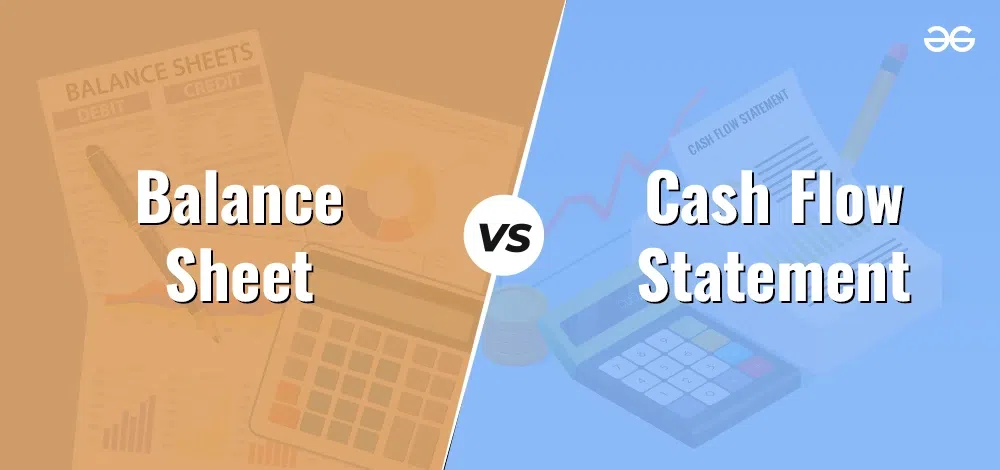Difference between Balance Sheet and Cash Flow Statement
Last Updated :
01 Mar, 2024
Balance Sheet and Cash Flow Statement are two of the most essential components In the field of financial management. The purpose of the preparation of the Balance Sheet and Cash Flow Statement for various companies and organisations is to gain valuable insights into the company’s financial status. Both these statements serve as milestones from different perspectives and provide distinct information to the associated stakeholders of the company. The balance sheet mainly focuses on the company’s financial position at one particular period, whereas the cash flow statement report examines the company’s cash Incoming and outgoing reports over a certain period.

What is Balance Sheet?
The Balance Sheet is the statement showing the business’s financial position at a given time. It is the statement showing the value of assets and liabilities of a firm at a certain date. The Balance Sheet shows the report of the property owned by the enterprise and the claims of the creditors and owners against these properties. The total of both sides (i.e., assets and liabilities) of the balance sheet should be equal.
The financial position of a firm is shown by its assets and liabilities on the given date. A company is financially stable when the assets are more than the liabilities, and it represents capital. The Balance Sheet is prepared from the Real Accounts and Personal Accounts. Ledger accounts that have not been closed having debit balances are shown on the assets side and those having credit balances are shown on the liabilities side.
What is Cash Flow Statement?
A statement showing flows of cash & cash equivalent during a specified time period is known as a Cash Flow Statement. Simply put, a cash flow statement is a summary of different sources and applications of cash during a specific time period and analyses the reasons behind changes in cash balance between the two balance sheet dates. (Here, ‘cash’ means cash & cash equivalent) Hence, one can prepare a cash flow statement if the two comparative balance sheets of a company are given. A cash flow statement includes only those items which affect cash.
Cash Flow Statements are divided into three main activities, which are stated below:
- Operating Activities: Operating activities in cash flow statements consist of sources and users of cash from primary business activities. It includes those activities which help an organisation in ascertaining the net profit or net loss of an enterprise.
- Investing Activities: The sale and purchase of investments and fixed assets, which are not held by a company for resale purposes are covered under Investing Activities. Cash flow from investing activities also discloses the expenditures incurred for the resources intended to generate future income and cash flows of the company.
- Financing Activities: The activities that bring a change in the capital and borrowings of a company are covered under Financing Activities. Cash Flow from Financing Activities helps the lenders of funds in estimating their claims on cash flows in the future. It is calculated by analysing the change in Equity and Preference Share Capital, Debentures, and other short-term and long-term borrowings.
Difference between Balance Sheet and Cash Flow Statement
|
Basis
|
Balance Sheet
|
Cash Flow Statement
|
| Purpose |
Balance Sheet is used to show the financial status of the company at a specific date. |
Cash Flow Statement is used in the company to have information about the cash inflows and outflows during a specific period. |
| Focus |
Balance Sheet mainly focuses on the financial position at a point in time. |
Cash Flow Statement focuses on the cash transactions over a specific period. |
| Components |
Balance Sheet has the components like Assets, Liabilities, and Equity of Stakeholders. |
Cash Flow Statement has the components like Operating Cash Flow, Investing Cash Flow, and Financing Cash Flow. |
| Accounting Parameter |
This includes both cash and non-cash transactions. |
This included only cash-based transactional transactions. |
| Usage |
Balance Sheet assists stakeholders to measure the financial liquidity and overall stability of the company. |
Cash Flow Statement assists in the overall evaluation of the company’s potential to generate cash and its cash management capabilities. |
| Limitations |
Balance Sheet does not offer a well-detailed view of the cash flows during the reporting time. |
Cash Flow Statement does not provide a comprehensive perspective of the company’s financial position. |
| Presentational Format |
Presented in 2-column horizontal format with the assets on the one side and liabilities & equity on another side and also in 2-section vertical format with liabilities first and assets afterwards. |
Presented in 3 section format describing cash flows from operating, investing, and financing activities. |
Share your thoughts in the comments
Please Login to comment...